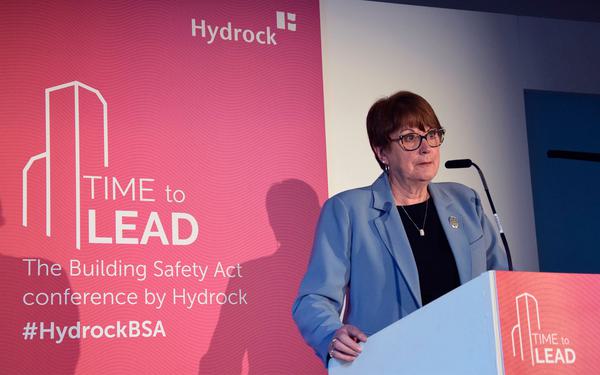Back to Articles
Our Time to Lead session: The higher education sector and the Building Safety Act
Graham Munday \ 31st Oct 2023
At our 'Time to Lead' conference on 18 October 2023, our break-out session dedicated to the higher education sector asked what the Building Safety Act (BSA) means for this sector.
Chaired by Marc Pawson, Hydrock's regional director in Scotland, our panellists were Dr Hywel Davies, Chief Technical Officer for CIBSE, Chris Waterman, Public Policy Advisor, and James McNay, deputy divisional director for Hydrock in our fire business.
A show of hands at the start of the session revealed that in an audience that included a number of representatives from university estate teams, no one felt sufficiently informed on what the BSA means to the higher education sector. So, what were the key talking points and take-aways - let's summarise:
1. Student accommodation - understanding the risk
In 2021/22, there were 2.2m registered students in the UK and the majority applied for student accommodation. Upskilling this sector on the applicability of the BSA to their buildings is key.
Hywel confirmed that student residential buildings that meet the threshold of being at least 18m in height or with at least seven storeys, qualify.
Hywel encouraged higher education estate teams to register these buildings, especially as the deadline has now passed. He referenced a fire in The Cube in Bolton in November 2020 as a good example of why these specific 'and/or' stipulations are in place for qualifying buildings. The Cube was 17.85m in height, but was seven storeys tall.
The BSA talks a lot about 'residents'. Obviously in the higher education sector, these 'residents' are students. Our panel agreed that this is an audience that offers a challenging dynamic.
Students are paying a lot of money to occupy these spaces, and the Act talks about the rights and responsibilities of residents. The advice of the panel, and the view of our audience, was that it is essential to ensure students understand the implications of the Act, and in turn their own responsibilities for safety and care of the building.
But a student population is transient. They move on quickly. Chris recommended having a 'resident engagement strategy' with a building safety committee: "You need a representative sample of students engaged, and then successive groups too [as students move on], to demonstrate you have a process for communicating safety and any changes to the accommodation", said Chris. "Digitise this engagement" was the advice from James to reach this resident population, and Hywel also emphasised the importance of "outcomes, not inputs, making not just engagement, but getting feedback really important."
2. Academic buildings as a workplace
Hywel emphasised that the BSA applies to any piece of notifiable building work that happens on the estate - from the smallest change to the largest construction. Proportionality is key, with a more rigorous approach for higher risk buildings.
A university is a workplace and intersects with the Building Safety Regulator over higher risk buildings and controlled building work. When this finishes, it intersects with the HSE as a workplace.
Many academic buildings will not meet the "high-risk" definition within Part 4 of the BSA, but from James's perspective they simply demonstrate a different kind of risk, for example laboratories and the materials stored in them. He also emphasised that risk takes different forms too, and argued that the risk of structural collapse in a heavily populated academic building is as much a risk as fire in a student accommodation block.
James said the most important thing is culture: "Being competent in every aspect of the Building Safety Act is not important, what is important is culture, and your approach. Have you checked the safety of all your buildings? The 18m rule for residential buildings is an arbitrary measure that indicates you need to start somewhere. The most important thing is to establish a baseline for all your buildings and understand their safety."
This point was supported and built on by a member of our audience who made the point that any baseline needs to be reviewed continually. For example, laboratory research facilities on university estates will, over time, be engaged in different research activities using different products, which will change the risk profile at any given time. The only people who know this are those responsible for running those specific facilities.
3. Who is responsible?
Section 4 of the Act is around managing risks in the buildings.
Hywel kicked off with a clear message to estate managers and teams: "be clear who the 'Principal Accountable Person [PAP]' is for buildings that are occupied."
"If, as the university, you own the block, then you are the PAP" said Hywel, "but if it's leased to a provider who is managing it, they may be the accountable person." So, the panel's advice was to understand who is responsible for day-to-day operations and to be clear on who will provide the safety case and maintain the golden thread. Equally, when work is carried out, Hywel emphasised the importance of being clear on who the PAP is with respect to who seeks the regulatory approvals.
Hywel also observed that for a residential block over the threshold height which has other uses, most likely on ground and lower floors, it's imperative to be clear on who is responsible for what, and how separate parts are managed. "If there is complete separation and independent exits for residential and other users" said Hywel, "it may be deemed as two buildings under Part 4 of the Act." Hywel's advice to the audience was to look at their buildings in detail and look at the regulations and get a competent view on this point.
Chris emphasised to the audience that the most important thing was to establish absolute clarity on who that PAP is and know what you are responsible for.
In terms of being responsible for design, Hywel recommended looking at the latest Building Regulations where there is a whole new section, Part 2A on Duty Holder and Competency. Amongst 17 new regulations, it states there is a duty on a 'client' to plan, monitor and manage design work. If there is a fire safety issue, Hywel warns that Building Control will ask if you've taken specialist advice, which confirms that there is a duty on everyone to collaborate on works.
The audience also sought clarity on the new role of Principal Designer (PD) under the BSA. Hywel confirmed that the PD takes the lead on the overall design and is responsible for compliance with Building Regulations, the Building Act and the BSA. This is now distinct to the role of Construction, Design and Management (CDM). As Hywel pointed out, the same person can do both roles and the legislation hints that this should be the case.
The distinction is that under CDM regulations, the PD role is about ensuring no one is injured during site work and that people responsible for maintaining a building are also safe. The PD role under the BSA is about making sure the building is designed and built to comply with all the aspects of the Building Regulations.

4. Funding challenge
As Chair, Marc asked how the sector was bringing together all the challenges of decarbonisation, ongoing maintenance, energy efficiency and the BSA into their estate management work.
From the floor, an example was offered of a decarbonisation programme at a medical school. In this case, it firstly illustrates that whilst this building doesn't meet the threshold of a high-risk building, it is a building with high-risk activities, including a range of laboratories. Secondly, the projects identified for decarbonisation have opened up discussions on all the other issues, expanding the potential cost to address these issues.
The feeling of the room was that the key is to address all this within one approach and budget. The challenge though, as one audience member opined, is that in practice, funding sources come from different places for different purposes.
The panel, and the audience agreed that this meant collaboration is key between teams. Work out who the ultimate owner is of each of these budgets and get the right people in the room to have the conversations on how to get best value for money from all the competing needs. The point was also made that to overcome different teams working on their projects in a silo, it's important to recognise the respective competencies of what everyone can bring to a situation to enable the best outcome - competency being a key word in the BSA.
5. The final word
Marc asked the panel for their final observations:
For Hywel, his advice to the higher education sector on the BSA is: "All the estate is included, and everyone in your estates team needs to be aware of this. Before you start any work, stop and ask who else do you need to talk to and involve."
James emphasised the point on proportionality: "If a building has a safety case, whether it is high-risk or not, proportionality simply changes how big the safety case is." Reflecting on how risk is managed in high hazard sectors, James said that for the built environment sector it's about "instilling a safety mentality and being held personally accountable if you do not follow the appropriate guidance."
Chris recommends to this sector to think about the power of sharing knowledge and experiences through their networks: "There will be people in every university who are fire safety and building safety officers, get them networked and sharing ideas."
Key takeaways
- Be clear on who the 'Principal Accountable Person' is for student accommodation buildings.
- Recognise that students, as residents, are transient, and develop an engagement process that ensures they understand their responsibilities to their accommodation, whilst also educating them on the safety aspects of their residency blocks.
- With academic buildings being considered workplaces, understand that risks manifest in different ways and should be considered proportionately. Check the safety of all your buildings.
- Identify who the budget holders are for all the change that an estate requires and ensure they collaborate to manage change in a coordinated way and to get best value for money.
Stay informed with our dedicated newsletter featuring news and updates, the latest talking points and everything else you might need to know about the Building Safety Act. Sign up here.

















